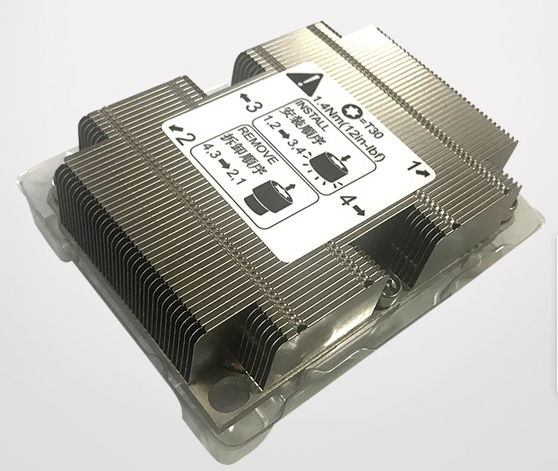
How to get a heat sink. Any device has a certain loss during operation, and most of the loss becomes heat. Low power devices have low loss and no heat sink. However, high-power devices have large losses. If heat dissipation measures are not taken, the temperature of the die can reach or exceed the allowable junction temperature, and the device will be damaged. Therefore, it is necessary to add a cooling device. The most commonly used is to install the power device on the radiator, use the radiator to dissipate the heat to the surrounding space, and add a cooling fan if necessary to enhance cooling and heat dissipation at a certain wind speed. On the power devices of some large-scale equipment, a flowing cold water cooling plate is also used, which has a better heat dissipation effect. Heat dissipation calculation is to determine the appropriate heat dissipation measures and radiator through calculation under certain working conditions. The power devices are mounted on the heat sink. Its main heat flow direction is from the die to the bottom of the device, and the heat is dissipated to the surrounding space through the heat sink. If there is no fan to cool at a certain speed, this is called free cooling or natural convection cooling.
There is a certain thermal resistance in the heat transfer process. The thermal resistance transmitted from the device wafer to the surface of the device is RJC, the thermal resistance between the device surface and the heat sink is R CS, the thermal resistance of the heat sink to the surrounding space is RSA, and the total thermal resistance RJA=Rjc+Rcs +Rsa. If the maximum power loss of the device is PD, and the allowable junction temperature of the device is known as TJ and the ambient temperature is TA, the allowable total thermal resistance R JA can be calculated as follows.
R JA≤(TJ-TA)/PD
Then calculate the maximum allowable heat sink to ambient temperature thermal resistance R SA as
R SA≤({T_{J}-T_{A}}Over{P_{D}})-(R JC+R CS)
For the consideration of leaving room for design, TJ is generally set to 125°C. The ambient temperature should also consider the worst case, generally set TA=40℃ 60℃. The size of the R JC is related to the size and package structure of the die, and can generally be found in the device data sheet. The size of the R CS is related to the mounting technology and the package of the device. If the device adopts thermal grease or thermal pad, and then installs it with the heat sink, the typical R CS value of the device is 0.1 0.2 ℃/W; if the bottom surface of the device is not insulated and additional mica sheet insulation is required, its R CS can reach 1 ℃/W W. PD is the actual maximum power loss, which can be calculated according to the working conditions of different devices. In this way, RSA can be calculated, and a suitable radiator can be selected according to the calculated RSA value.
Computing instance
A power operational amplifier PA02 (product of APEX company) is used as a low-frequency power amplifier, and its circuit is shown in Figure 1. The device is available in an 8-pin TO-3 metal case package. The working conditions of the device are as follows: the working voltage VS is 18V; the load impedance RL is 4 Ω, the working frequency can reach 5kHz under the DC condition, the ambient temperature is set to 40°C, and natural cooling is adopted.
Looking at the PA02 device data, it can be seen that the typical quiescent current IQ is 27mA, and the maximum value is 40mA; the typical value of the device’s R JC (from the die to the case) is 2.4°C/W, and the maximum value is 2.6°C/W.
The power dissipation of the device is PD:
PD=PDQ+PDOUT
In the formula, PDQ is the power consumption of the internal circuit of the device, and PDOUT is the power consumption of the output power. PDQ=IQ(VS+|-VS|), PDOUT=V^{2}_{S}/4RL, substitute into the above formula
PD=IQ(VS+|-VS|)+V^{2}_{S}/4RL=37mA(36V)+18V2/4 4=21.6W
In the formula, the quiescent current is taken as 37mA.
Calculation of radiator thermal resistance
R SA: R SA≤({T_{J}-T_{A}}Over{P_{D}})-(R_{ JC}+R_{ CS}})
In order to leave a margin, TJ is set to 125°C, TA is set to 40°C, R JC takes the maximum value (R JC=”2″.6°C/W), R CS takes 0.2°C/W, (PA02 is directly installed on the heat sink. on the device, with thermal grease in the middle). Substitute the above data into the formula to get
R SA≤{125℃-40℃}Over{21.6W}-(2.6℃/W+0.2℃/W)≤1.135℃/W
The thermal resistance of HSO4 is 0.95℃/W under natural convection, which can meet the heat dissipation requirements.
Precautions
1. The maximum power consumption value in the device data sheet cannot be taken in the calculation, but should be calculated according to the actual conditions; the maximum junction temperature in the data sheet is generally 150°C, and there is room for 125°C in the design, and the ambient temperature is also Can not take 25 ℃ (consider summer and the actual temperature of the chassis).
2. The installation of the radiator should consider the direction that is conducive to heat dissipation, and the cooling holes should be opened at the corresponding position on the chassis or casing (so that the cold air enters from the bottom and the hot air escapes from the top).
3. If the shell of the device is an electrode, the mounting surface is not insulated (not insulated from the internal circuit). Mica spacers must be used for insulation during installation to prevent short circuits.
4. The pins of the device should pass through the heat sink, and holes should be drilled on the heat sink. In order to prevent the pin from colliding with the hole wall, a PTFE sleeve should be covered.
5. In addition, different types of radiators have different thermal resistances under different heat dissipation conditions, which can be modified during design, that is, in practical applications, the thermal resistance of these radiators can be calculated, and similar structural shapes can be used ( The radiator composed of profiles with cross-sectional area and perimeter) is used instead.
6. In the above calculation, some parameters are set, which may be different from the actual values, and the dimensions of the substitute models are not exactly the same. Therefore, a simulation test should be done during mass production to confirm whether the radiator is suitable. Some corrections (such as the length of the profile or changing the model of the profile, etc.) can only be mass-produced.
